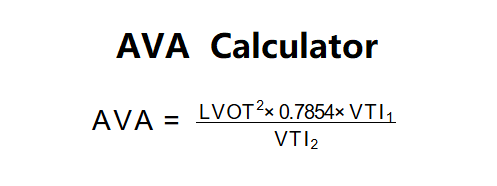1. What is the Aortic Valve Area (AVA) Calculator?
Definition: The Aortic Valve Area (AVA) Calculator estimates the area of the aortic valve using echocardiographic measurements. It is a key parameter in assessing aortic stenosis severity.
Purpose: It helps clinicians evaluate the degree of aortic valve narrowing, which is critical for diagnosing and managing aortic stenosis, a condition that can lead to heart failure if untreated.
2. How Does the Calculator Work?
The calculator uses the following formula to compute the Aortic Valve Area (AVA):
The severity of aortic stenosis is determined based on the AVA in cm²:
- AVA < 1 cm²: Severe
- AVA 1–1.5 cm²: Moderate
- AVA 1.5–3 cm²: Mild
- AVA > 3 cm²: Normal
Inputs:
- LVOT Diameter (cm, mm, in)
- Subvalvular Velocity Time Integral (VTI₁) (cm, mm, in)
- Maximum Velocity Time Integral (VTI₂) (cm, mm, in)
Unit Conversions:
- Length (LVOT, VTI₁, VTI₂): cm, mm, in (1 cm = 10 mm, 1 in = 2.54 cm)
- Area (AVA): cm², mm², in² (1 cm² = 100 mm², 1 cm² = 0.155 in²)
Steps:
- Input the LVOT diameter and select its unit.
- Input the subvalvular VTI (VTI₁) and select its unit.
- Input the maximum VTI (VTI₂) and select its unit.
- Compute the AVA using the formula.
- Select the desired output unit for AVA (cm², mm², in²) using the dropdown.
- View the aortic stenosis severity based on the AVA in cm².
3. Importance of AVA Calculations
The AVA calculation is useful for:
- Diagnosing Aortic Stenosis: An AVA less than 1.0 cm² typically indicates severe aortic stenosis, requiring medical intervention.
- Guiding Treatment: Helps determine the need for procedures like valve replacement in patients with symptomatic aortic stenosis.
- Monitoring Disease Progression: Tracks changes in valve area over time to assess worsening of the condition.
4. Using the Calculator
Examples:
- LVOT: 2 cm, VTI₁: 20 cm, VTI₂: 50 cm, Output in cm²:
AVA: \( \frac{2^2 \times 0.7854 \times 20}{50} \)
\( = \frac{4 \times 0.7854 \times 20}{50} = \frac{62.832}{50} \approx 1.26 \, \text{cm}^2 \).
Severity: Moderate (AVA 1–1.5 cm²).
- LVOT: 20 mm, VTI₁: 0.8 in, VTI₂: 100 mm, Output in in²:
LVOT in cm: \( 20 \div 10 = 2 \, \text{cm} \).
VTI₁ in cm: \( 0.8 \times 2.54 \approx 2.03 \, \text{cm} \).
VTI₂ in cm: \( 100 \div 10 = 10 \, \text{cm} \).
AVA in cm²: \( \frac{2^2 \times 0.7854 \times 2.03}{10} \approx 0.64 \, \text{cm}^2 \).
AVA in in²: \( 0.64 \div 6.4516 \approx 0.10 \, \text{in}^2 \).
Severity: Severe (AVA < 1 cm²).
5. Frequently Asked Questions (FAQ)
Q: What does a 'Severe' AVA result mean?
A: An AVA less than 1.0 cm² indicates severe aortic stenosis, which often requires surgical intervention such as valve replacement.
Q: Why is the severity based on cm² even if I select a different output unit?
A: The severity classification is standardized in cm², as this is the unit used in clinical guidelines for assessing aortic stenosis.
Q: Can I use this calculator for other heart valves?
A: No, this calculator is specific to the aortic valve. Other valves, like the mitral valve, require different formulas and measurements.
Aortic Valve Area (AVA) Calculator© - All Rights Reserved 2025
 Home
Home
 Back
Back
